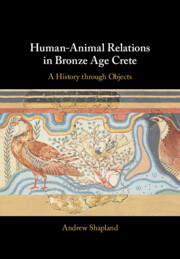Refine search
Actions for selected content:
5894 results in Classical art and architecture
Two - Looking
-
- Book:
- Human-Animal Relations in Bronze Age Crete
- Published online:
- 28 April 2022
- Print publication:
- 12 May 2022, pp 29-63
-
- Chapter
- Export citation
Chapter 6 - Black Disguises in an Aithiopian Novel
-
- Book:
- Untangling Blackness in Greek Antiquity
- Published online:
- 12 April 2022
- Print publication:
- 12 May 2022, pp 158-186
-
- Chapter
- Export citation
Seven - Collecting
-
- Book:
- Human-Animal Relations in Bronze Age Crete
- Published online:
- 28 April 2022
- Print publication:
- 12 May 2022, pp 182-211
-
- Chapter
- Export citation
Chapter 2 - Masks of Blackness
-
- Book:
- Untangling Blackness in Greek Antiquity
- Published online:
- 12 April 2022
- Print publication:
- 12 May 2022, pp 29-65
-
- Chapter
- Export citation
Copyright page
-
- Book:
- Untangling Blackness in Greek Antiquity
- Published online:
- 12 April 2022
- Print publication:
- 12 May 2022, pp iv-iv
-
- Chapter
- Export citation
Figures
-
- Book:
- Untangling Blackness in Greek Antiquity
- Published online:
- 12 April 2022
- Print publication:
- 12 May 2022, pp vi-vii
-
- Chapter
- Export citation
Abbreviations
-
- Book:
- Untangling Blackness in Greek Antiquity
- Published online:
- 12 April 2022
- Print publication:
- 12 May 2022, pp xvi-xviii
-
- Chapter
- Export citation
Chapter 3 - Masks of Difference in Aeschylus’s Suppliants
-
- Book:
- Untangling Blackness in Greek Antiquity
- Published online:
- 12 April 2022
- Print publication:
- 12 May 2022, pp 66-97
-
- Chapter
- Export citation
Chapter 5 - From Greek Scythians to Black Greeks
-
- Book:
- Untangling Blackness in Greek Antiquity
- Published online:
- 12 April 2022
- Print publication:
- 12 May 2022, pp 129-157
-
- Chapter
- Export citation
References
-
- Book:
- Human-Animal Relations in Bronze Age Crete
- Published online:
- 28 April 2022
- Print publication:
- 12 May 2022, pp 228-268
-
- Chapter
- Export citation
Copyright page
-
- Book:
- Human-Animal Relations in Bronze Age Crete
- Published online:
- 28 April 2022
- Print publication:
- 12 May 2022, pp iv-iv
-
- Chapter
- Export citation
Eight - The Naturalistic Spirit
-
- Book:
- Human-Animal Relations in Bronze Age Crete
- Published online:
- 28 April 2022
- Print publication:
- 12 May 2022, pp 212-220
-
- Chapter
- Export citation
Notes
-
- Book:
- Human-Animal Relations in Bronze Age Crete
- Published online:
- 28 April 2022
- Print publication:
- 12 May 2022, pp 221-227
-
- Chapter
- Export citation
Preface
-
- Book:
- Human-Animal Relations in Bronze Age Crete
- Published online:
- 28 April 2022
- Print publication:
- 12 May 2022, pp xi-xiv
-
- Chapter
- Export citation
Three - Herding
-
- Book:
- Human-Animal Relations in Bronze Age Crete
- Published online:
- 28 April 2022
- Print publication:
- 12 May 2022, pp 64-100
-
- Chapter
- Export citation

Human-Animal Relations in Bronze Age Crete
- A History through Objects
-
- Published online:
- 28 April 2022
- Print publication:
- 12 May 2022
TWO - Souvenirs of Cult Statues
- from Part I
-
- Book:
- Souvenirs and the Experience of Empire in Ancient Rome
- Published online:
- 20 May 2022
- Print publication:
- 21 April 2022, pp 25-59
-
- Chapter
- Export citation
Dedication
-
- Book:
- Souvenirs and the Experience of Empire in Ancient Rome
- Published online:
- 20 May 2022
- Print publication:
- 21 April 2022, pp v-vi
-
- Chapter
- Export citation
Acknowledgments
-
- Book:
- Souvenirs and the Experience of Empire in Ancient Rome
- Published online:
- 20 May 2022
- Print publication:
- 21 April 2022, pp xiv-xxii
-
- Chapter
- Export citation
ONE - Introduction: Souvenirs of the Roman Empire
-
- Book:
- Souvenirs and the Experience of Empire in Ancient Rome
- Published online:
- 20 May 2022
- Print publication:
- 21 April 2022, pp 1-22
-
- Chapter
- Export citation
